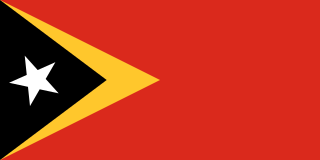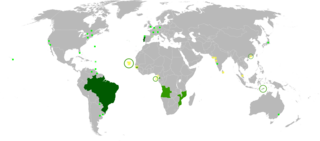
Dili, also known as “City of Peace”, is the capital, largest city, chief port, and commercial centre of East Timor (Timor-Leste). Dili is part of a free trade zone, the Timor Leste–Indonesia–Australia Growth Triangle (TIA-GT).

East Timor is a country in Southeast Asia, officially known as Democratic Republic of Timor-Leste. The country comprises the eastern half of the island of Timor and the nearby islands of Atauro and Jaco. The first inhabitants are thought to be descendant of Australoid and Melanesian peoples. The Portuguese began to trade with Timor by the early 16th century and colonised it throughout the mid-century. Skirmishing with the Dutch in the region eventually resulted in an 1859 treaty for which Portugal ceded the western half of the island. Imperial Japan occupied East Timor during World War II, but Portugal resumed colonial authority after the Japanese surrender.

Baucau is a municipality, and was formerly a district, of East Timor, on the northern coast in the eastern part of the country. The capital is also called Baucau. The population of the municipality is 111,694 and it has an area of 1,506 km².
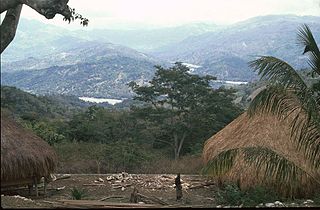
Bobonaro Municipality is a municipality in the Democratic Republic of Timor-Leste commonly known as East Timor. It is the second-most western municipality on the east half of the island. It has a population of 92,045 and an area of 1,376 km².

The National University of East Timor, based in the East Timorese capital Dili, is the major institution of higher education in East Timor.
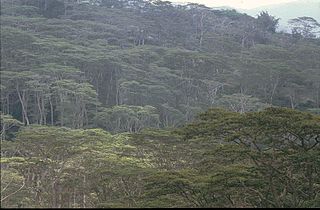
Ermera is one of the municipalities of East Timor, located in the west-central part of the country. It has a population of 117,064 and an area of 746 km².
The Liquiçá Church massacre was a mass-killing that occurred in April 1999, during East Timor's bid for independence. It was the first case to be heard by the Second Special Panel.
Besi Merah Putih, meaning 'red and white iron' in Indonesian, is the official name of a pro-Indonesia militia operating in the district of Liquiçá, and originating in the village of Maubara.
The Manuel Carrascalão House massacre occurred on 17 April 1999 in Dili, East Timor, at the house of East Timorese independence leader Manuel Carrascalão. 12 people were killed by the pro-Indonesia Aitarak militia, commanded by Eurico Guterres, including Carrascalão's 17-year-old son Manelito, who was tortured and hacked to death. The bodies of the victims were transported to the village of Maubara, the headquarters of the Besi Merah Putih militia, where they were buried, in coffins, with personal possessions and identification. The bodies were exhumed in 2000, by the UNTAET Crime Scene Detachment.
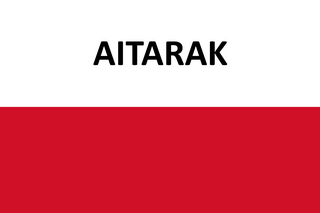
Aitarak was the name of one of the most feared pro-Indonesia militia groups in East Timor during the late 1990s. On April 17, 1999, the group conducted 12 murders at the Manuel Carrascalão House massacre in Dili. That same month members took part in the Liquiçá Church massacre. At its height, the group was led by Eurico Guterres.
Manuel Viegas Carrascalão was an Indonesian parliamentarian and prominent East Timorese independence leader. The Carrascalão family is of mestiço ancestry; Carrascalao was born on Atauro Island.
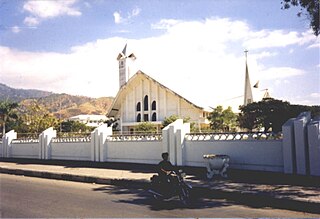
Dili is one of the 13 municipalities, formerly districts, of Timor-Leste, which includes the national capital Dili. It had a population of 277,279 as of 2015, most of whom live in the capital city. The municipality has an area of 368.12 km2 (142.13 sq mi). The municipality continued the same name as the council had in Portuguese Timor.
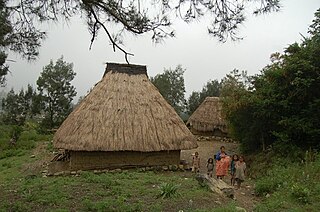
Maliana is a city in East Timor, 149 km southwest of Dili, the national capital. It has a population of 22,000. It is the capital of the district of Bobonaro and Maliana Subdistrict, and is located just a few kilometers from the border with Indonesia. It is also the see city of the Roman Catholic Diocese of Maliana, which was formed by Pope Benedict XVI with territory taken from the Roman Catholic Diocese of Dili.

Casa Europa is an historic late nineteenth-century Portuguese colonial building in the Bidau Lecidere suco of Dili, capital city of East Timor. Initially a Portuguese Quartel de Infantaria, it became the home of the municipality of Dili administration in the late 1930s. Following the Japanese occupation of Portuguese Timor, it reverted to being a Portuguese military facility until 1972, and was later taken over by the Indonesian military. Now the oldest building in the city centre, it has since been renovated and given its present name, and presently houses European diplomatic representatives.
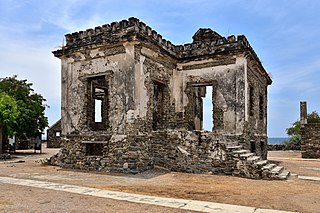
Ai Pelo Prison or Aipelo Prison is an historic late nineteenth-century Portuguese colonial prison in the Lauhata suco, East Timor, adjacent to the Savu Sea. It was deactivated in 1939 and is now a ruin.

The Banco Nacional Ultramarino (BNU) building in the centre of Dili, capital city of East Timor, is a modernist structure unusual in Timor. Constructed between 1966 and 1968, it has only one contemporary, the headquarters of the Timor Commercial, Agricultural and Industrial Association. As a consequence of political turbulence culminating in the Indonesian invasion of East Timor in 1975, the BNU closed down its Timor operations. However, since 2001 the building has again been occupied by BNU Timor, now a trading name of the Portuguese bank Caixa Geral de Depósitos.


